 |
 |
 |
| HOME | CONTENTS | JOIN HERE | |||||
| ABOUT
PAC | |||||||
|
So began the incredible story of how Norfolk's greatest pike angler took a shine to the young lad who would go on to catch a record and eclipse even his captures. To this 10-year-old lad, the pair of 30lb pike that stared down at the clientele in Dennis Pye's Norwich chippy looked like monsters. "Have you ever caught anything like that," said the man behind the counter, as he deftly wrapped a cod and chips supper in last night's Evening News. "No, I've never even seen anything as big as that," Derrick Amies replied. "What are you doing tomorrow," asked Pye. School, said Derrick. "You don't have to go to school, you can come fishing with me - it's up to you." Back in the days when bunking off was more likely to land you a clip round the ear than a social worker on your doorstep, the Thurne and its broads boasted the kind of fishing dreams were made of. "That
first time we ever went fishing was for bream on the Thurne. He was looking for
some company, that's what it Derrick was taken into Pye's close circle of fishing mates, most of whom also owned chip shops around the Norfolk capital. A former sergeant in the army, Pye had his troops well organised. "We'd go fishing on Friday night, Saturday and Saturday. If we caught any bait-sized roach they'd all go in a wooden cage ready for Tuesday, when Dennis would go pike fishing."
"Finally my chance came to go with Dennis for pike," said Derrick. "I didn't fish but rowed the boat under instruction. Straight on, left, left again and let the boat drift. No splashing, no noise inside, gently on the oars. Dennis was scanning the water, then he turned and said: Whatever happens, I don't want you to get excited. I just thought: 'Tosser!' We put the weights in very carefully. He said he wanted me to sit still and not move. He put out a roach live bait and his first fish was 25lbs and ounces. Then he had another one on. I turned to him and he had the rod tucked under his arm while he was rolling a fag. I went ballistic. It's bigger, I screamed. Don't lose it - you're going to lose it. He just scowled: 'Sit down boy. When you sit down, I'll land it.' He did land it - 31 Ibs and the second pike I saw Dennis catch. The master was simply giving me a lesson. If your pike is well-hooked, there's no need to panic, no need to rush."
Before long, Derrick caught his first 20 - a 21 Ibs 8oz Horsey fish. He's subsequently caught 153 of them - not to mention nine 30s and two 40s.
Pye put in more effort than the other locals. And his dumb-bell was the killing method during the Broads' heyday, head and shoulders above everything else. Like so many discoveries the bizarre floats, with which he and Derrick perfected their own unique slant on working a live bait, came about by accident. "I
made a mistake one day," Derrick said. "I was fishing with a gazette
float and so was he. It went under and I said I'm away and wound down. He said:
'That's the bait'. "Two minutes later, it did the same again and Dennis,
with some anger in his voice, said put a bigger float on. I said I hadn't got
one, so he stuck a pilot float on the peg at the top of my bung." The added buoyancy was enough to stop the bait from pulling the float under. By their next trip, Pye had fashioned a dumb-bell float out of two one-inch cork balls on a stem. It didn't take them long to realise they'd discovered a way to steer a bait and control its progress as it worked a weed bed or along a reed fringe. "There's
only one way to live bait and that's with a dumb-bell float," said Derrick.
"While dumb-bell fishing you can only use one rod. To do the job correctly
requires 100 per cent concentration. It's like riding a bike, you can only do
one thing at a time. Grease the line, drop it over the side, pay out some line
and the roach will swim against the resistance." "I've perfected it to a fine art, you'd be stunned if you knew what I could do with it," said Derrick, pointing out of the window. "You see those two trees in the garden..? You could cast a dead bait there but if the pike's not feeding, it's not going to have it. Cast a spoon or a plug and you've got to bring it straight back to you as soon as you start to retrieve it, not covering any pike close to the cover. If I put a live bait on I can make it go to the left of the trees, go back past to the right - I don't know which way a pike's going to be lying but I will cover any pike in the swim. Angling for non-feeding pike has to be approached with great care. The pike is very well-equipped to analyse all types of activity surrounding it. If a large pike is not feeding, it may not take the bait if it's got time to sit there and be aware that it's coming. But if I make my bait approach from a different direction, i.e. so it comes up from behind, I might get a take. The delicate manoeuvres I have learnt produced amazing control. It's exciting and still gives me a real buzz, knowing how to fish a known swim or feature gives me a big edge." Derrick
maintains the vast majority of us don't live bait properly. Bish nods sagely.
Our free roamers and drifters are usually left at the mercy of the bait, the wind
or the current - with none of Derrick's control. The key to the dumb-bell is at
close range, in a few feet of water, it allows you to steer the bait and work
it around likely areas with no unnatural movement. "I would describe dumb-bell live baiting as angling for pike, as opposed to sitting back after setting a trap for them," added Derrick. "It's a very skilful method."
"Dave Plummer and I were out in my boat. I was positioning the boat, as I wanted it positioned a particular way and Dave had his bait in before me," he said. "I put my bait in the water, worked it along a reed bed and got the gentlest take you can imagine. I thought it was a jack. I've seen thousands of takes. That's why I don't like bite alarms - if you see a take and which way it goes, that can teach you something about pike behaviour. I thought it was a jack until I wound down and pulled into it. I got it in the net and Dave said: 'Twenty-seven, twenty-eight..?' I said you're having a laugh - thirty-five plus at least..!" The fish, which went to 35 - plus an extra 7lbs 2oz for good measure - turned out to be a familiar one. Local lad Paul Belsten had already caught it at 34lbs and Neville Fickling had caught it at 41lbs 6oz and claimed the record months earlier, while a number of other Norfolk anglers had also bumped into the fish on its way to the magical 40lbs mark. "Someone
had to catch it at its biggest weight and that happened to be me," shrugged
Derrick. "If I were to pass on piece of advice for pikers wishing to catch the bigger pike, it would be not to concentrate on the roach shoals, as recommended by all the modern writers of today," he went on. "I simply disagree with that line of thought, there is far more to large pike location than that. Knowledge is a wonderful thing to have, it does not come overnight. I have been forced to take two 10-year breaks from piking due to business and personal reasons, at 60 I still go today because I enjoy it." "I still have total belief in the dumb-bell method nearly 40 years after Dennis Pye introduced it. I simply fine-tuned it." Ask
him why and he won't be drawn. Ask for his thoughts on feeding periods - more
exactly how to be in the right place on the rare occasions when the big fish of
the Broads go on the feed and he won't be drawn. "You really ought to write
a book one day," says Bish our photographer, as he rifles Derrick's clippings
and articles for clues. "You don't think I'm going to tell everyone how to
do it while I'm still out there piking do you," he smiles. This
article first appeared in Pikelines 105 (August 2004) - on this website 30/03/06 |
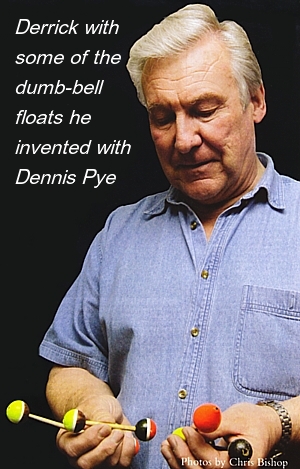 Derrick
Amies never dreamed he's be taken under the wing of Broadland legend Dennis Pye
when his Granny sent him down the chip shop...
Derrick
Amies never dreamed he's be taken under the wing of Broadland legend Dennis Pye
when his Granny sent him down the chip shop...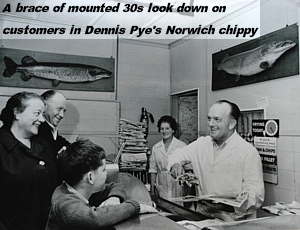 It
was a while before Pye trusted his new recruit to accompany him on a piking trip.
But in the meantime, the fishing was something else. "The rudd were phenomenal,"
said Derrick. "We'd fish a swim on the float for three or four minutes, move
and fish another one. The boat was positioned 30yds from the reed beds - casting
right into the fringes and gaps in the reed. Bang - you'd get one as soon as it
hit the water, the float didn't have time to cock."
It
was a while before Pye trusted his new recruit to accompany him on a piking trip.
But in the meantime, the fishing was something else. "The rudd were phenomenal,"
said Derrick. "We'd fish a swim on the float for three or four minutes, move
and fish another one. The boat was positioned 30yds from the reed beds - casting
right into the fringes and gaps in the reed. Bang - you'd get one as soon as it
hit the water, the float didn't have time to cock."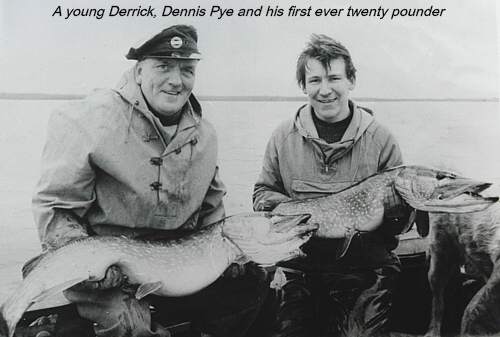 Before
long Derrick was like a son to Pye, down the pub playing cards and darts, while
in the close season they were down the Thurne, maintaining the boats. It was Pye
who bought Derrick his first boat, in an era when many anglers in the Norwich
area travelled to the broads by bicycle. "Dennis said when and where we would
fish for roach, rudd, tench, bream, perch and of course pike," said Derrick.
"The Thurne system is some 2,500 acres of rivers and broads. Fish location
was a learning curve. We would target a species according to the weather, the
month of the year and the tidal influence - and nail 'em."
Before
long Derrick was like a son to Pye, down the pub playing cards and darts, while
in the close season they were down the Thurne, maintaining the boats. It was Pye
who bought Derrick his first boat, in an era when many anglers in the Norwich
area travelled to the broads by bicycle. "Dennis said when and where we would
fish for roach, rudd, tench, bream, perch and of course pike," said Derrick.
"The Thurne system is some 2,500 acres of rivers and broads. Fish location
was a learning curve. We would target a species according to the weather, the
month of the year and the tidal influence - and nail 'em."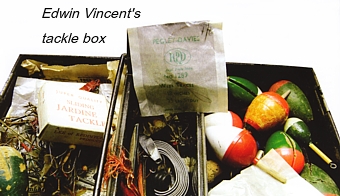 "Edwin
Vincent, he only wobbled a dead roach. He was a single method man. His dad, Jim
Vincent, only ever fished with a spoon," said Derrick. "Old Len Spencer
he'd fish with a little Gazette bung, tiny three ounce roach underneath it and
you'd never see him do anything else. Dennis Pye, all he ever did was fish live
bait on a dumb-bell. They were very tunnel-visioned on what they were doing but
because there was such a big volume of fish there they made the methods work.
They did catch fish, a lot of fish, and a lot of pike. But if you look at how
many big pike Edwin or Jim Vincent caught they weren't a patch on Dennis. He had
that special determination to succeed. It wasn't because they weren't good enough;
it was because the methods they used weren't good enough."
"Edwin
Vincent, he only wobbled a dead roach. He was a single method man. His dad, Jim
Vincent, only ever fished with a spoon," said Derrick. "Old Len Spencer
he'd fish with a little Gazette bung, tiny three ounce roach underneath it and
you'd never see him do anything else. Dennis Pye, all he ever did was fish live
bait on a dumb-bell. They were very tunnel-visioned on what they were doing but
because there was such a big volume of fish there they made the methods work.
They did catch fish, a lot of fish, and a lot of pike. But if you look at how
many big pike Edwin or Jim Vincent caught they weren't a patch on Dennis. He had
that special determination to succeed. It wasn't because they weren't good enough;
it was because the methods they used weren't good enough."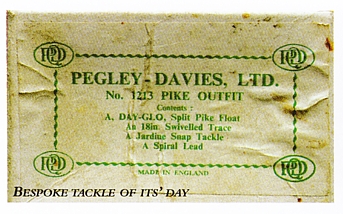 Watercraft
and stealth were all in an age when Norfolk pikemen fished at close range from
boats, with tackle we'd sneer at now. Yet the likes of Pye and Dennis produced
the kind of results those who fish the Broads today can only marvel at - with
their split cane rods and centrepins, when cutting edge end tackle meant a Pegley
Davies No 1213 Pike Outfit with its bung, snap tackle and spiral lead. Derrick's
study is like a miniature museum, crammed with priceless memorabilia and photographs
from the golden era of pike fishing, the like of which most of us will probably
never live to see. Spinning flights and bungs are all neatly packed away in Edwin
Vincent's metal tackle box, a rare piking treasure, along with a pristine Heddon
plug - one of the first American lures imported to these shores more than 40 years
ago. Sample chapters of a pike fishing book Vincent failed to find a publisher
for sit in a drawer - neatly filed with encouraging notes from Geoff Bucknall.
Watercraft
and stealth were all in an age when Norfolk pikemen fished at close range from
boats, with tackle we'd sneer at now. Yet the likes of Pye and Dennis produced
the kind of results those who fish the Broads today can only marvel at - with
their split cane rods and centrepins, when cutting edge end tackle meant a Pegley
Davies No 1213 Pike Outfit with its bung, snap tackle and spiral lead. Derrick's
study is like a miniature museum, crammed with priceless memorabilia and photographs
from the golden era of pike fishing, the like of which most of us will probably
never live to see. Spinning flights and bungs are all neatly packed away in Edwin
Vincent's metal tackle box, a rare piking treasure, along with a pristine Heddon
plug - one of the first American lures imported to these shores more than 40 years
ago. Sample chapters of a pike fishing book Vincent failed to find a publisher
for sit in a drawer - neatly filed with encouraging notes from Geoff Bucknall.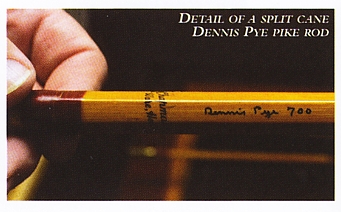 Derrick
is very much his own man, who has learned from others and tried to come up with
correct answers to the questions that need answering - fish behaviour due to rates
of temperature changes, barometric pressure, month-to-month changes including
moon phases, general weather fronts effecting day-to-day changes. Any piker would
die for the papers in Derrick's study. The split cane rod, on which Derrick caught
his 42lbs 2oz record is stowed in its bag, while the certificate authenticating
its capture nearly 20 years ago hangs nearby. Derrick admits he couldn't tell
us the exact date he got married off the top of his head. But he talks us through
what happened just after 6a.m., on the morning of August 23, 1985, like it happened
last week.
Derrick
is very much his own man, who has learned from others and tried to come up with
correct answers to the questions that need answering - fish behaviour due to rates
of temperature changes, barometric pressure, month-to-month changes including
moon phases, general weather fronts effecting day-to-day changes. Any piker would
die for the papers in Derrick's study. The split cane rod, on which Derrick caught
his 42lbs 2oz record is stowed in its bag, while the certificate authenticating
its capture nearly 20 years ago hangs nearby. Derrick admits he couldn't tell
us the exact date he got married off the top of his head. But he talks us through
what happened just after 6a.m., on the morning of August 23, 1985, like it happened
last week.